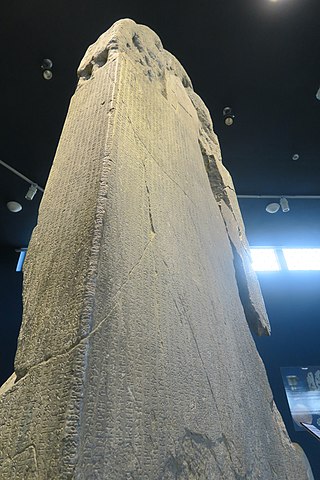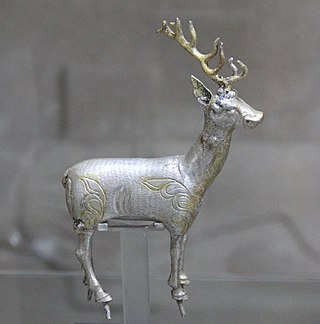Bumin Qaghan (Old Turkic: 𐰉𐰆𐰢𐰣:𐰴𐰍𐰣, romanized: Bumïn qaɣan, also known as Illig Qaghan or Yamï Qaghan was the founder of the Turkic Khaganate. He was the eldest son of Ashina Tuwu. He was the chieftain of the Turks under the sovereignty of Rouran Khaganate. He is also mentioned as Tumen of the Rouran Khaganate.

Kul Tigin was a general and a prince of the Second Turkic Khaganate.
Tonyukuk was the baga-tarkhan and adviser of four successive Göktürk khagans – Ilterish Qaghan, Qapaghan Qaghan, Inel Qaghan and Bilge Qaghan. He conducted victorious campaigns against various Turkic and non-Turkic steppe peoples, such as Tölis, Xueyantuo, Toquz Oguz, Yenisei Kyrgyz, Kurykans, Thirty Tatar, Khitan and Tatabi as well as the Tang dynasty. He was described as a kingmaker by historians such as E. P. Thompson and Peter Benjamin Golden.
Ilterish Qaghan was the founder of the Second Turkic Khaganate.

The Ashina were a Turkic tribe and the ruling dynasty of the Göktürks. This clan rose to prominence in the mid-6th century when the leader, Bumin Qaghan, revolted against the Rouran Khaganate. The two main branches of the family, one descended from Bumin and the other from his brother Istämi, ruled over the eastern and western parts of the Göktürk confederation, respectively, forming the First Turkic Khaganate (552–603).
Muqan Qaghan was the second son of Bumin Qaghan and the third khagan of the Göktürks who expanded their khaganate and secured the borders against the Hephthalites, making it the biggest country ever existing at the time.
Illig Qaghan, born Ashina Duobi, posthumous name Prince Huang of Guiyi (歸義荒王), was the last qaghan of the Eastern Turkic Khaganate.

The Xueyantuo were an ancient Tiele tribe and khaganate in Northeast Asia who were at one point vassals of the Göktürks, later aligning with the Tang dynasty against the Eastern Göktürks.

The Eastern Turkic Khaganate was a Turkic khaganate formed as a result of the internecine wars in the beginning of the 7th century after the First Turkic Khaganate had splintered into two polities – one in the east and the other in the west. Finally, the Eastern Turkic Khaganate was defeated and absorbed by the Tang dynasty, and Xueyantuo occupied the territory of the former Turkic Khaganate.
Qapaghan or Qapghan Qaghan was the second khagan of the Second Turkic Khaganate during Wu Zetian's reign and was the younger brother of the first kaghan, Ilterish Qaghan.

The Orkhon inscriptions are two memorial installations erected by the Göktürks written in the Old Turkic alphabet in the early 8th century in the Orkhon Valley in what is modern-day Mongolia. They were erected in honor of two Turkic princes, Kul Tigin and his brother Bilge Khagan.
Xue Ne, was a Chinese military general and politician of the Tang dynasty and of Wu Zetian's Zhou dynasty, serving as a chancellor and major general during the reign of Emperor Xuanzong.

The Second Turkic Khaganate was a khaganate in Central and Eastern Asia founded by Ashina clan of the Göktürks that lasted between 682–744. It was preceded by the Eastern Turkic Khaganate (552–630) and the early Tang dynasty period (630–682). The Second Khaganate was centered on Ötüken in the upper reaches of the Orkhon River. It was succeeded by its subject Toquz Oghuz confederation, which became the Uyghur Khaganate.
Tengri Qaghan was the sixth ruler of the Second Turkic Khaganate.
Kutluk Yabgu Khagan was one of the last yabghus (rulers) of the Second Turkic Khaganate.
Qutluğ Säbig Qatun was the khatun (queen) and then hansha of the Second Turkic Khaganate. She served as regent during the minority of Tengri Qaghan in 734-741.
Alp Bilge Qağan or Eletmiş Qağan was a Basmyl chief who rebelled and brought Second Turkic Khaganate to an end.
Saqal was a Turgesh Qaghan. According to Yuri Zuev, he was a Manichaeist so that his name was possibly derived from Manichean theonym Sakla which means "Creator of the World". Other reconstructions are Saqal and Soq.
El Bilga Khatun or Ilbilga Katun was the wife of the 8th century Göktürk Turkic Qaghan, Ilterish Qaghan, the founder of the Second Turkic Khaganate and the mother of Bilgä Qaghan, the fourth Qaghan of the same Khaganate. She is mentioned in the Orkhon inscriptions erected in honor of Bilgä Qaghan and his brother.

The Silver Deer of Bilge Qaghan is a 7th- or 8th-century silver and silver-gilt artifact extracted from the tomb of Bilge Qaghan, the burial complex of the fourth Qaghan of the Second Turkic Khaganate. It was discovered in 2001 during excavations carried out in Orkhon Valley, at the future Bilge Khan Monumental Grave Complex, located about 400 km (250 mi) from Mongolia's capital Ulaanbaatar, between the Orkhon River and Khosho Tsaydam Lake.









